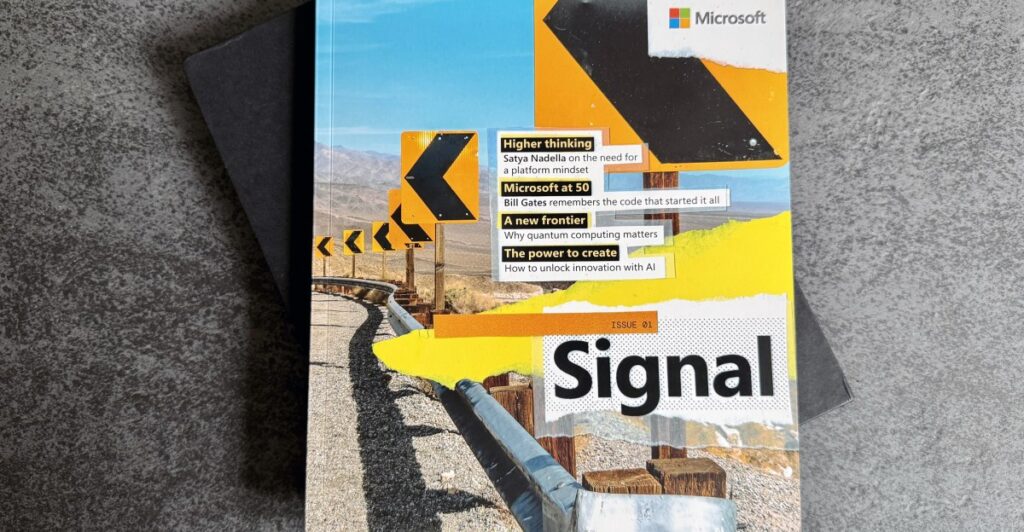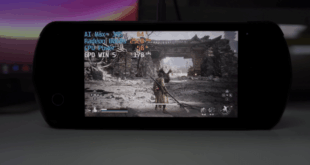
Of all the many ways Microsoft could mark its 50th anniversary, I wasn’t expecting the software maker to launch a magazine. “It’s our answer to a timely question: How do we earn trust and hold attention in an age of scroll and skim? How do we create Signal in a world of noise?” asks Frank Shaw, Microsoft’s chief communications officer.
Microsoft’s response to a world of people doomscrolling on X and TikTok is a print magazine that you can thumb through in peace and quiet. The first issue of Signal is 120 pages with a focus on AI, both as a topic and, to a small degree, a means of production. Microsoft hopes the magazine will bypass the digital world and reach business leaders directly every few months.
“People are overloaded with information, and a lot of the information is pretty ephemeral,” says Steve Clayton, the executive editor of Signal, in an interview for Notepad. “[Signal is] partly a reaction to that, which is: how do we create something that’s more thoughtful and has some more permanence, and is a bit longer-lasting than a five-second TikTok video?”
Signal looks like any high-quality magazine you’d find at a newsstand, complete with deep dives on Microsoft technologies, interviews with Microsoft executives, and some lighthearted quiz and trivia sections to round off the magazine format. It’s a magazine from Microsoft’s comms team, so don’t expect to read anything about Amazon or Google in here, or material that strays beyond a clean and tidy image of Microsoft. Instead, you’ve got guest appearances from CEO Satya Nadella and co-founder Bill Gates in the premiere issue I’ve read.

The deeper stories on Microsoft will look very familiar to anyone who has read Microsoft’s Source work, where the company writes its own stories about how its technology is being used throughout the world. These digital stories are a good reminder of how influential Microsoft is, but they’re not yarns that the company can easily pitch to journalists like me because they’re simply too self-promotional. Signal feels like a physical manifestation of Microsoft’s strategy with its Source stories.
“Microsoft Source and Microsoft stories has been our opportunity to go direct,” says Clayton. Microsoft has printed 1,500 copies of Signal that it’s distributing at its own business-focused events. “Fifteen hundred is a good place to start, and the uptake has been really good. There’s been a lot of demand for it,” says Clayton. “If we get through those and see more demand that we can’t fulfill, then we’ll go and do another print run.”
The publication schedule is still in flux as Microsoft gauges interest. “We’re starting to think about what the next few editions will be, and based on the reaction to this one, that will determine the size of the next print run,” says Clayton. Microsoft didn’t want to print 15,000 and have them sitting on shelves at its events, so it’s treading carefully for now with plans to publish every quarter or so.
A big inspiration for Signal was the Costco magazine that’s distributed to millions of members every month, a reach that makes it one of the largest magazines in the country and a steady way for the retailer to reach its customers. “The facility, the team, and production that they’d set up, we have a lot of that capability already, so it was an opportunity for us to turn our attention to a new thing,” says Clayton. Costco mails out more than 15 million copies of its magazine with each issue, but Microsoft isn’t expecting to scale Signal to those heights yet. “I don’t think we’re going to go and compete with Costco’s magazine anytime soon, put it that way,” says Clayton.
Signal, as you might expect, is very focused on how Microsoft’s technology is being used by businesses. That means it’s also very much focused on AI. I counted mentions on more than 50 of its 120 pages. There’s a story about a women’s soccer team in Spain that was recently promoted and grappled with the use of AI, a deep dive into how Vodafone is deploying AI, and another piece on how Microsoft’s research labs are using AI for science.
There are also parts of Signal that look more clearly like promotional material for companies using Microsoft technology, or the types of customer stories that wouldn’t interest readers of The Verge. But there are also interesting, meatier stories. The Vodafone piece might sound like pure marketing, but I could see how it might be useful as a less technical guide for other CTOs thinking about rolling out AI.

Microsoft’s Copilot AI assistant helped build small parts of the first issue of Signal, but it’s unclear how deep that’ll go in story creation in future issues. “We certainly didn’t go in intentionally and say that we’re going to have an AI-generated story,” says Clayton. “At the back of the magazine there’s a small quiz that’s generated by Copilot, so you could argue that piece is generated by AI.”
Clayton also says he used the deep research functionality of Copilot to help develop Microsoft’s periodic table. “I definitely see us using AI to help us do some of the research and production, and I think we’re open to what we can do with AI in the magazine, but it’s not something that’s front and center,” he says.
Microsoft has been working with the Slow Journalism Company in the UK to help produce Signal. “I’ve long been a fan of their work and they were a big help in writing some of the pieces as well, and we’ll continue to work with them,” says Clayton. “They have great writing and editorial talent, and also they just know how to produce a magazine.”
Learning how to create a magazine has been a big part of Microsoft’s experiment with Signal. A magazine has to have lighter pieces of content, and it all needs to be arranged in a compelling way to keep readers engaged. There’s a fine art to keep people turning a page in a magazine that’s different from getting someone to click on an online piece.
I’ve enjoyed reading Signal, especially the soccer piece and the 50-year anniversary stories. Like any magazine there are parts I could happily skip over, but the design, attention to detail, and stories here are surprising for Microsoft’s first issue. I’m very curious to see whether a trend back to print emerges across other tech companies, and how many hands Signal actually ends up in.
- Microsoft’s LinkedIn chief is now running Office as part of an AI reorg. Microsoft’s LinkedIn CEO, Ryan Roslansky, is taking on an expanded role at the software maker as the head of Office. In an internal memo seen by The Verge, CEO Satya Nadella reveals that the move is part of an AI shake-up that also sees Charles Lamanna and the business and industry Copilot (BIC) team move closer to the Microsoft 365 Copilot side of the company. This shake-up is very interesting because now the separate leaders of Microsoft 365 Copilot and the business Copilot teams both report to Rajesh Jha. In the past nobody has really owned Copilot inside Microsoft, but Jha has a lot more power over the business side of it now. The consumer Copilot will still be run by Microsoft AI CEO Mustafa Suleyman.
- Surface Pro 12-inch review: heart warmer. I’ve spent the past few weeks trying out Microsoft’s design changes to the Surface Pro. I think it’s the closest the company has ever come to creating the ideal miniature PC. The 12-inch model has the right mix of design, power, and battery life, and it’s very much a heartwarmer rather than the heartbreak that the Surface Pro X was.
- Bing lets you use OpenAI’s Sora video generator for free. Microsoft has added a new AI video generator option to its Bing mobile app. It uses OpenAI’s Sora text-to-video model, and provides a free way for anyone to generate short clips with Sora without a ChatGPT subscription. This continues Microsoft’s efforts to make OpenAI’s models free in Bing or Copilot, but the Sora quality is still far behind models like Google’s Veo 3.
- Microsoft is laying off more than 300 employees. A month after Microsoft laid off more than 6,000 people, it’s doing another fresh round of cuts in Redmond, Washington. This time more than 300 have been affected, and I’ve heard some of those are in Microsoft’s legal teams. I’ve spoken to nearly a dozen current employees and every single one of them is concerned about the ongoing layoffs. The random nature of these cuts and the fact Microsoft isn’t doing them all in one go has really hit morale inside the company. I don’t think the layoffs are over, either. I keep hearing that there will be Xbox-related layoffs soon, potentially by the end of the month.
- Microsoft will finally stop bugging Windows users about Edge — but only in Europe. Microsoft is making some more changes to Windows in response to the Digital Markets Act. Windows users in the EEA can now uninstall the Microsoft Store and avoid nags or prompts to set Edge as the default browser. I wish Microsoft would extend these options worldwide, as they’re simply far more consumer-friendly, and would help to repair some of the distrust consumers have in Windows 11 at the moment.
- Microsoft releases a bold new update for Notepad. Microsoft is adding text formatting, including bold and italic styling, to its Notepad app on Windows 11. There will even be support for hyperlinks and Markdown, thanks to a new formatting toolbar at the top of Notepad. Microsoft has been tweaking Notepad heavily ever since it removed WordPad from Windows, and the app can even now generate text for you using AI.
- QA workers at ZeniMax reach a tentative contract agreement. More than 300 quality assurance workers of the ZeniMax Workers United-CWA union have reached a tentative contract agreement with Microsoft. My colleague Ash Parrish reports that this is “the first contract agreement at Microsoft since the concerted effort to unionize the video game industry began roughly four years ago.”
- Microsoft wants to end USB-C port confusion with Windows 11. Not all USB-C ports are created equal, and Microsoft is fed up with the confusion around using USB-C accessories. It has found that 27 percent of PCs with USB 4 have encountered a limited functionality notification in Windows, meaning a PC maker hasn’t implemented USB 4 properly. “The reversible USB Type-C connector isn’t the problem, the inconsistent implementations of USB-C port capabilities across the PC ecosystem is,” says Microsoft in a blog post. Now that USB-IF has introduced clearer branding guidelines on USB-C capabilities and speed, Microsoft is enforcing these through its Windows Hardware Compatibility Program (WHCP) to ensure all mobile systems with USB data, charging, and display “just works” for all USB-C ports. Microsoft is also forcing systems that support USB 40Gbps to also provide compatibility with USB 4 and Thunderbolt 3, so you know peripherals are properly supported.
- The new Outlook for Windows gets better PST support. Microsoft has been trying to improve the new Outlook for Windows for months now, in direct response to its lukewarm reception. You can now reply and forward emails in a PST file, move emails between accounts, and search folders while offline. Microsoft has also tweaked the default mail sync window to 30 days, up from just seven days. And if you’re not interested in Copilot, there’s now an easy way to disable the AI assistant in Outlook.
- Researcher and analyst agents are now available in Microsoft 365 Copilot. Microsoft’s two new deep reasoning agents are now generally available in Microsoft 365 Copilot. Researcher relies on OpenAI’s deep research AI model to perform complex research, and it also hooks into third-party data via connectors like Salesforce or ServiceNow. Analyst is based on OpenAI’s o3-mini reasoning model, and it can turn raw data into spreadsheets.
I’m always keen to hear from readers, so please drop a comment here, or you can reach me at notepad@theverge.com if you want to discuss anything else. If you’ve heard about any of Microsoft’s secret projects, you can reach me via email at notepad@theverge.com or speak to me confidentially on the Signal messaging app, where I’m tomwarren.01. I’m also tomwarren on Telegram, if you’d prefer to chat there.
Thanks for subscribing to Notepad.
 Latest World Breaking News Online News Portal
Latest World Breaking News Online News Portal






